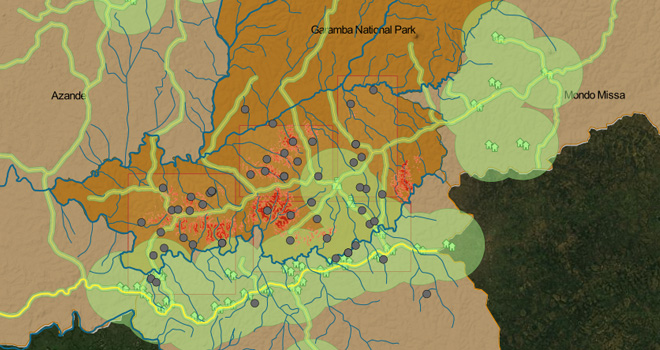
Read the full report here (PDF)
View the interactive report here (in a new window)
Introduction
Poachers are killing the elephants of Garamba National Park in the Democratic Republic of the Congo at an unprecedentedly rapid pace. Since mid-April of 2014, park rangers have found the carcasses of 131 elephants, slaughtered for their tusks. Unlike in the past, when criminal gangs carried out most of the poaching, the main actors appear to be heavily armed groups using professional techniques. Some of the poachers have been involved in Central Africa’s many conflicts and have carried out multiple atrocities against civilians, creating much misery and suffering over the past decade.
The Lord’s Resistance Army (LRA), renegade elements of the Congolese national army (the FARDC), and armed poachers from South Sudan and Sudan, have led this recent upsurge in poaching. These groups, in contrast to the criminal gangs, use their revenues from poaching in part to fund their continuing military activities through purchases or food, weapons, ammunition and other supplies.
This increase in poaching is both qualitatively and quantitatively different from previous experience at Garamba. In the past, poachers have relied on relatively low technology tools and have tended to kill one or two elephants at a time. According to African Parks, which manages Garamba on behalf of the Congolese government, the recent attacks have resulted in three to eight elephants being killed at a time, with the tusks often being removed by chainsaws. There is evidence of at least nine elephants being shot from helicopters.
This report is a follow-up to a report produced in 2013 by the Enough Project, The Resolve, Invisible Children, and the Satellite Sentinel Project, with DigitalGlobe’s assistance, that described how the LRA poaches elephants in the Democratic Republic of the Congo’s Garamba National Park. It seeks to use satellite imagery and predictive analytics to assist the park’s rangers to level the playing field with the poachers and better protect the dwindling elephant population. Since the 1980s, the Garamba elephant population has fallen to about 2,400 from approximately 20,000, largely due to poaching. This effort to use the latest technology to better equip rangers to protect elephants is currently being tested in Garamba, but if the partnership with the park’s rangers is successful, it can be replicated in other parks across Africa.
The slaughter of African elephants for their valuable ivory has reached the point that according to the World Conservation Society (WCS), 96 elephants are killed each day. WCS’s 96 Elephants coalition, of which the Enough Project is a member, estimates that poachers killed 35,000 elephants in 2012. The pace of poaching is putting pressure on a continental elephant population that has declined by more than 50 percent in the past 30 years.
Ivory prices have reached a record high because of high demand in east and southeast Asia, especially China. On the black market in Asia, elephant tusks are valued at $1,000 to $1,300 per pound. With adult male elephant tusks weighing roughly 135 pounds and adult female tusks weighing 20 pounds, a single elephant tusk can sell for $20,000 to $175,500 on the Asian market. Groups involved in the smuggling of tusks from Africa to Asia pocket the majority of this revenue, as they pay regional poachers around $23 per pound (or $50 per kilo) and then sell the same tusk to middlemen for roughly $200 per kilo.
Read the full report here (PDF)
View the interactive report here (in a new window)

